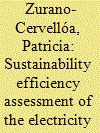|
|
|
Sort Order |
|
|
|
Items / Page
|
|
|
|
|
|
|
| Srl | Item |
| 1 |
ID:
182723


|
|
|
|
|
| Summary/Abstract |
One of the most undesirable output of China's rapid economic growth has been increasing carbon emissions. This study measures and analyzes the impact of carbon emissions on China's regional total factor productivity from 2000 to 2017. Using global Malmquist-Luenberger productivity indexes, we re-estimate the provincial total factor productivity taking carbon emission into account, comparing different assumptions of returns to scale and considering the rank reverse issue. The differences of technical progress and efficiency change across Chinese regional economies are also investigated and we found that the former was the primary contributor to improved Chinese provincial productivity performance. In addition, we analyze the influencing factors of productivity based on provincial panel data. Our results indicate that innovation capacity, energy and employment structure had significant impact on the provincial productivities while urbanization had a negative impact. A more sustainable development can be expected by expanding regional investment in R&D, adjusting and optimizing structures of regional industries and energies.
|
|
|
|
|
|
|
|
|
|
|
|
|
|
|
|
| 2 |
ID:
150014


|
|
|
|
|
| Summary/Abstract |
Climate change has become one of the most challenging issues facing the world. Chinese government has realized the importance of energy conservation and prevention of the climate changes for sustainable development of China's economy and set targets for CO2 emissions reduction in China. In China industry contributes 84.2% of the total CO2 emissions, especially manufacturing industries. Data envelopment analysis (DEA) and Malmquist productivity (MP) index are the widely used mathematical techniques to address the relative efficiency and productivity of a group of homogenous decision making units, e.g. industries or countries. However, in many real applications, especially those related to energy efficiency, there are often undesirable outputs, e.g. the pollutions, waste and CO2 emissions, which are produced inevitably with desirable outputs in the production. This paper introduces a novel Malmquist–Luenberger productivity (MLP) index based on directional distance function (DDF) to address the issue of productivity evolution of DMUs in the presence of undesirable outputs. The new RAM (Range-adjusted measure)-based global MLP index has been applied to evaluate CO2 emissions reduction in Chinese light manufacturing industries. Recommendations for policy makers have been discussed.
|
|
|
|
|
|
|
|
|
|
|
|
|
|
|
|
| 3 |
ID:
126593


|
|
|
|
|
| Publication |
2013.
|
| Summary/Abstract |
In the process of setting operational targets to achieve sustainable development of economy, environment and natural resources, estimation of potential energy saving and potential CO2 emission reduction becomes extremely important. This estimation can be conducted based on the energy efficiency evaluation for different decision-making units (DMUs) by data envelopment analysis (DEA). Non-fossil energy is an important component of energy consumption in China, and it has great impacts on energy efficiency and energy-related carbon dioxide (CO2) emissions. This paper proposes a non-radial DEA model to evaluate regional energy efficiencies in China. In the proposed model, non-fossil energy is treated as a fixed input. Based on the model, a method of measuring potential energy saving and CO2 emission reduction for efficiency improvement is also presented. The proposed approaches are illustrated by using a regional dataset in China. Based on the application results, some implications for improving energy efficiency and reducing CO2 emissions in China are provided.
|
|
|
|
|
|
|
|
|
|
|
|
|
|
|
|
| 4 |
ID:
150385


|
|
|
|
|
| Summary/Abstract |
This paper aims to offer an advanced assessment methodology for sustainable national energy-environment-economic efficiency strategies, based on an extended Data Envelopment Analysis (DEA). The use of novel efficiency-improving approaches based on DEA originates from the so-called Distance Friction Minimisation (DFM) method. To design a feasible improvement strategy for low-efficiency DMUs, we develop here a Target-Oriented (TO) DFM model. However, in many real-world cases input factors may not be flexibly adjusted in the short run. In this study, we integrate the TO-DFM model with a fixed (inflexible) factor (FF) approach to cope with such more realistic circumstances. Super-efficiency DEA is next used in our comparative study on the efficiency assessment of energy-environment-economic targets for the EU, APEC and ASEAN (A&A) countries, employing appropriate data sets from the years 2003 to 2012. We consider two inputs (primary energy consumption and population) and two outputs (CO2 and GDP), including a fixed input factor (viz. population). On the basis of our DEA analysis results, EU countries appear to exhibit generally a higher efficiency than A&A countries. The above-mentioned TO-DFM-FF projection model is able to address realistic circumstances and requirements in an operational sustainability strategy for efficiency improvement in inefficient countries in the A&A region.
|
|
|
|
|
|
|
|
|
|
|
|
|
|
|
|
| 5 |
ID:
171409


|
|
|
|
|
| Summary/Abstract |
The implementation of a national emissions trading scheme (ETS) in China is likely to have an important effect on potential regional gains. This study proposes a unified analytical framework for anticipating such gains in 2020 and estimates the key factors involved using data envelopment analysis based models. The results indicate that: (1) when the value of the marginal abatement cost is higher than the carbon price, no regions will have an incentive to reduce emissions by technological improvements. The only source of direct potential gains is from the amounts of carbon quota. (2) As carbon price increases from CNY 10 to 4000 per ton, the indirect potential gains will increase because the strategies for carbon reduction are technological innovation or limit economic activities. However, Jiangsu and Shanghai will suffer potential losses even though the price is high because they have no more carbon reduction potential. (3) Most central provinces will have potential gains when the carbon price is lower in ETS, while regions rich in fossil energy sources will suffer potential losses. However, a middle-price interval of CNY 1000–2000/ton is more rational, because it helps motivate market transactions and benefits low-carbon technological innovations.
|
|
|
|
|
|
|
|
|
|
|
|
|
|
|
|
| 6 |
ID:
171402


|
|
|
|
|
| Summary/Abstract |
The solar photovoltaic poverty alleviation project (PPAP) is an important innovation in China's targeted poverty alleviation (TPA) mission. Through investment in the renewable energy industry and an emphasis on poverty alleviation in rural areas, China's TPA has achieved great success. Although China has invested large amounts of money in PPAP, its actual contribution to rural poverty alleviation has not been verified. This paper analyzes the contribution of PPAP's efficiency in TPA via data envelopment analysis (DEA) and grey relation analysis (GRA). The results show that: 1) the overall efficiency of TPA is high; 2) the overall efficiency of TPA has large geographical differences; 3) the inputs of TPA have a great impact on the efficiency of poverty alleviation; and 4) China's investment in PPAP is indeed effective, but its impact on poverty alleviation is overestimated. Therefore, we propose four policy recommendations: 1) the scale and proportion of financial investment in TPA should be optimized; 2) local governments should allocate poverty alleviation funds according to local situations; 3) the Chinese central government should strengthen macro control and reduce support for PPAP; and 4) local governments should balance the allocation of funds for PPAP and other poverty alleviation projects.
|
|
|
|
|
|
|
|
|
|
|
|
|
|
|
|
| 7 |
ID:
169738


|
|
|
|
|
| Summary/Abstract |
Assessing the sustainability level of the power sector can aid the transition towards a sustainable energy system. In this contribution, we propose a novel approach to compare and optimize electricity mixes according to sustainability criteria and apply it to the 28 EU members. Our method combines life cycle assessment, data envelopment analysis (DEA) and rigorous mathematical programming tools in three main steps. Firstly, DEA is applied to assess the efficiency level of electricity mixes of EU member countries considering the three dimensions of sustainability. Then, electricity portfolios of inefficient countries are optimized by solving a model that seeks to attain the targets provided by DEA while simultaneously considering the technical aspects governing electricity generation. This model, which constitutes the cornerstone of our approach, complements standard DEA by ensuring realistic and meaningful targets. In the third step, we evaluate the electricity portfolios optimized previously by running DEA again. Our results suggest that energy policies in the EU should favor the deployment of hydropower, wind and solar, while simultaneously displacing non-renewable sources and bioenergy. The deployment of carbon capture and storage is also a potential alternative that could be incentivized via policies worded in terms of carbon intensity targets.
|
|
|
|
|
|
|
|
|
|
|
|
|
|
|
|
|
|
|
|
|